November 2, 1976 1980 → 297 240 50.1% 48.0% Location United States of America | Turnout 53.6% 1.6 pp 40,831,881 39,148,634 Date 2 November 1976 | |
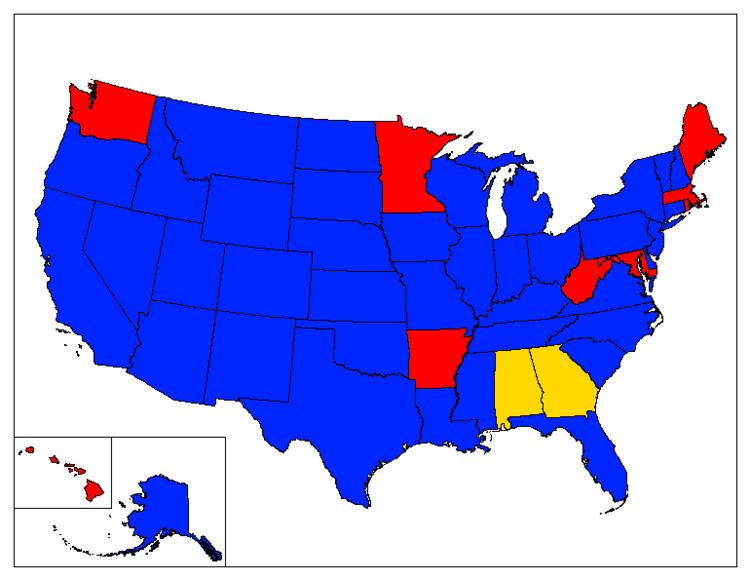 | ||
Winner Jimmy Carter Other Instances United States presidenti, United States presidenti, United States presidenti, United States presidenti, United States presidenti | ||
The United States presidential election of 1976 was the 48th quadrennial presidential election, held on Tuesday, November 2, 1976. The winner was the relatively unknown Jimmy Carter, a former Governor from Georgia with his running mate, Walter Mondale, the U.S. Senator from Minnesota, the Democratic candidates, over the incumbent President Gerald Ford from Michigan and his running mate, Bob Dole, the U.S. Senator from Kansas, the Republican candidates.
Contents
- Democratic Party
- Republican Party
- Others
- Fall campaign
- Results
- Statistics
- Results by state
- Close states
- Voter demographics
- Characteristics
- References

President Richard Nixon had resigned in 1974 in the wake of the Watergate scandal, but before doing so, he appointed Ford as Vice President via the 25th Amendment after Spiro Agnew resigned in the light of a scandal that implicated him in receiving illegal bribes while serving as Governor of Maryland. Ford was thus the only sitting President who had never been elected to national office. Saddled with a poor economy, the fall of South Vietnam, and paying a heavy political price for his pardon of Nixon, Ford first faced serious opposition from within his own party, when he was challenged for the Republican Party’s nomination by former California governor and future President Ronald Reagan. The race was so close that Ford was unable to secure the nomination until the Party Convention. Carter, who was less well known than other Democratic hopefuls, ran as a Washington outsider and reformer. He narrowly won the election, becoming the only president to date ever elected from Georgia and the first from the Deep South since Zachary Taylor in 1848.
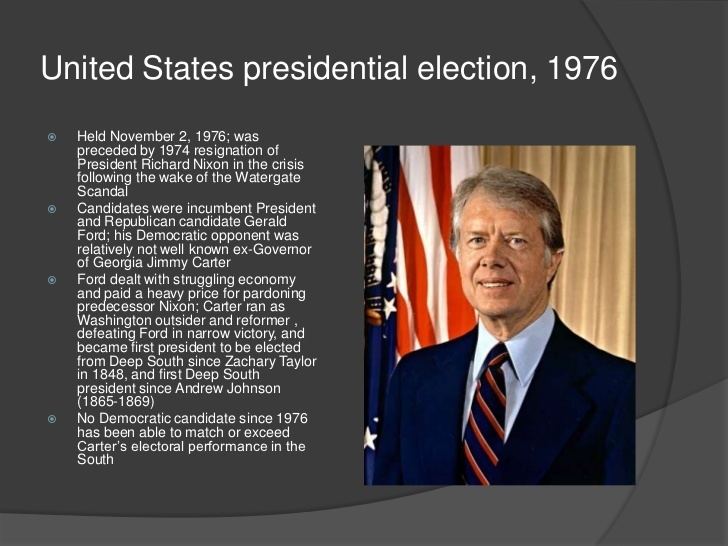
It was a notable election as all four presidential and vice-presidential candidates would ultimately lose a presidential election. Ford lost this year’s election and Carter failed in his bid for re-election in 1980; Mondale lost the 1984 election to incumbent Ronald Reagan in a landslide, and Dole lost his 1996 bid to incumbent Bill Clinton. It was also the most recent presidential election where the candidate who won the most states did not win the election, as well as the last time Alabama, Mississippi, South Carolina and Texas voted for the Democratic candidate. This is the earliest presidential election in which at least one major party candidate is still alive as of 2017, as Carter and both of the vice-presidential nominees, Dole and Mondale, are still living.
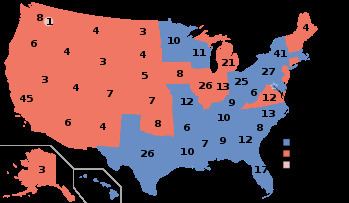
This would be the only election which the Democratic party won in a 28 year period, with the party not winning any other elections between 1964 and 1992.
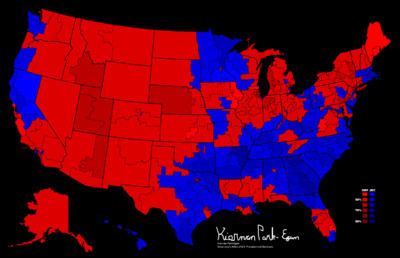
Democratic Party
Democratic candidates
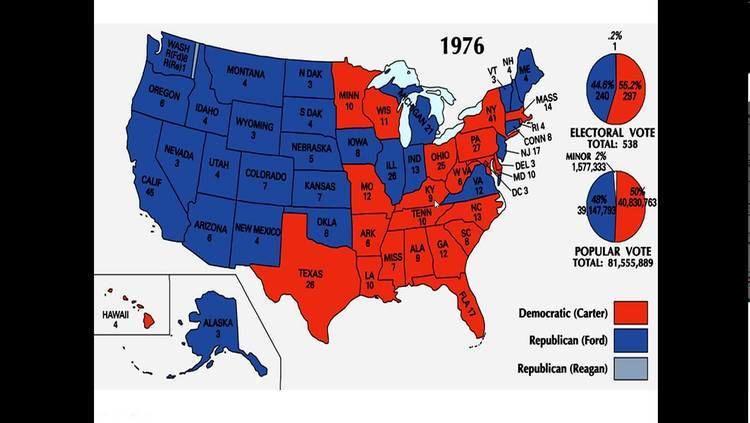

The surprise winner of the 1976 Democratic presidential nomination was Jimmy Carter, a former state senator and governor of Georgia. When the primaries began, Carter was little-known at the national level, and many political pundits regarded a number of better-known candidates, such as Senator Henry M. Jackson from Washington, Representative Morris Udall from Arizona, Governor George Wallace of Alabama, and California Governor Jerry Brown, as the favorites for the nomination. However, in the wake of the Watergate scandal, Carter realized that his status as a Washington outsider, political centrist, and moderate reformer could give him an advantage over his better-known establishment rivals. Carter also took advantage of the record number of state primaries and caucuses in 1976 to eliminate his better-known rivals one-by-one.

Senator Jackson made a fateful decision not to compete in the early Iowa caucus and New Hampshire primary, which Jimmy Carter won after liberals split their votes among four other candidates. Though Jackson went on to win the Massachusetts and New York primaries, he was forced to quit the race on May 1 after losing the critical Pennsylvania primary to Carter by twelve percentage points. Carter then defeated Governor Wallace, his main conservative challenger, by a wide margin in the North Carolina primary, thus forcing Wallace to end his campaign. Representative Udall, a liberal, then became Carter's main challenger. He finished second to Carter in the New Hampshire, Massachusetts, Wisconsin, New York, Michigan, South Dakota, and Ohio primaries, and won the caucuses in his home state of Arizona, while running even with Carter in the New Mexico caucuses. However, the fact that Udall finished second to Carter in most of these races meant that Carter steadily accumulated more delegates for the nomination than he did.
As Carter closed in on the nomination, an “ABC” (Anybody But Carter) movement started among Northern and Western liberal Democrats who worried that Carter’s Southern upbringing would make him too conservative for the Democratic Party. The leaders of the “ABC” movement – Idaho Senator Frank Church and California Governor Jerry Brown – both announced their candidacies for the Democratic nomination and defeated Carter in several late primaries. However, their campaigns started too late to prevent Carter from gathering the remaining delegates he needed to capture the nomination.
By June 1976, Carter had captured more than enough delegates to win the Democratic nomination. At the 1976 Democratic National Convention, Carter easily won the nomination on the first ballot; Udall finished in second place. Carter then chose Minnesota Senator Walter Mondale, a liberal and political protégé of Hubert Humphrey, as his running mate.
Republican Party
Republican candidates
The contest for the Republican Party's presidential nomination in 1976 was between two serious candidates: incumbent president Gerald Ford from Michigan, a member of the party's moderate wing, and former governor of California, Ronald Reagan, a member of the party's conservative wing. The presidential primary campaign between the two men was hard-fought and relatively even; by the start of the Republican Convention in August 1976, the race for the nomination was still too close to call. Ford defeated Reagan by a narrow margin on the first ballot at the 1976 Republican National Convention in Kansas City, and chose Senator Bob Dole from Kansas as his running mate in place of incumbent Vice President Nelson Rockefeller, who had announced the previous year that he was not interested in being considered for the Vice Presidential nomination. The 1976 Republican Convention was the last political convention to open with the presidential nomination still being undecided until the actual balloting at the convention.
Others
Fall campaign
One of the advantages Ford held over Carter as the general election campaign began was that, as president, he was privileged to preside over events dealing with the United States Bicentennial; this often resulted in favorable publicity for Ford. The Washington, D.C., fireworks display on the Fourth of July was presided over by the president and televised nationally. On July 7, 1976, the president and First Lady served as hosts at a White House state dinner for Elizabeth II and Prince Philip of the United Kingdom, which was televised on the Public Broadcasting Service (PBS) network. These events were part of Ford’s “Rose Garden” strategy to win the election; instead of appearing as a typical politician, Ford presented himself as a "tested leader" who was busily fulfilling the role of national leader and Chief Executive. Not until October did Ford leave the White House to campaign actively across the nation.
Jimmy Carter ran as a reformer who was “untainted” by Washington political scandals, which many voters found attractive in the wake of the Watergate scandal that had led to President Richard Nixon's resignation. Ford, although personally unconnected with Watergate, was seen by many as too close to the discredited Nixon administration, especially after he granted Nixon a presidential pardon for any crimes he might have committed during his term of office. Ford's pardon of Nixon caused his popularity, as measured by public-opinion polls, to plummet. Ford’s refusal to explain his reasons for pardoning Nixon publicly (he would do so in his memoirs several years later), also hurt his image.
Ford unsuccessfully asked Congress to end the 1950s-era price controls on natural gas, which caused a dwindling of American natural gas reserves after the 1973 Oil Crisis. Carter stated during his campaign that he opposed the ending of the price controls and thought such a move would be "disastrous."
After the Democratic National Convention, Carter held a 33-point lead over Ford in the polls. However, as the campaign continued, the race greatly tightened. During the campaign Playboy magazine published a controversial interview with Carter; in the interview, Carter admitted to having “lusted in my heart” for women other than his wife, which cut into his support among women and evangelical Christians. Also, on September 23, Ford performed well in what was the first televised presidential debate since 1960. Polls taken after the debate showed that most viewers felt that Ford was the winner. Carter was also hurt by Ford's charges that he lacked the necessary experience to be an effective national leader, and that Carter was vague on many issues.
However, Ford also committed a costly blunder in the campaign that halted his momentum. During the second presidential debate on October 6, Ford stumbled when he asserted that “there is no Soviet domination of Eastern Europe and there never will be under a Ford administration.” He added that he did not “believe that the Poles consider themselves dominated by the Soviet Union”, and made the same claim with regards to Yugoslavia and Romania. (Yugoslavia was not a Warsaw Pact member.) Ford refused to retract his statement for almost a week after the debate; as a result his surge in the polls stalled and Carter was able to maintain a slight lead in the polls.
A vice-presidential debate, the first ever formal one of its kind, between Bob Dole and Walter Mondale also hurt the Republican ticket when Dole asserted that military unpreparedness on the part of Democratic presidents was responsible for all of the wars the U.S. had fought in the 20th century. Dole, a World War II veteran, noted that in every 20th-century war from World War I to the Vietnam War, a Democrat had been President. Dole then pointed out that the number of U.S. casualties in “Democrat wars” was roughly equal to the population of Detroit. Many voters felt that Dole’s criticism was unfairly harsh and that his dispassionate delivery made him seem cold. Years later, Dole would remark that he regretted the comment, having viewed it as hurting the Republican ticket. One factor which did help Ford in the closing days of the campaign was a series of popular television appearances he did with Joe Garagiola, Sr., a retired baseball star for the St. Louis Cardinals and a well-known announcer for NBC Sports. Garagiola and Ford appeared in a number of shows in several large cities. During the show Garagiola would ask Ford questions about his life and beliefs; the shows were so informal, relaxed, and laid-back that some television critics labelled them the "Joe and Jerry Show." Ford and Garagiola obviously enjoyed one another's company, and they remained friends after the election was over.
Results
Despite his campaign’s blunders, Ford managed to close the remaining gap in the polls and by election day, the race was judged to be even. It took most of that night and the following morning to determine the winner. It wasn’t until 3:30 am (EST), that the NBC television network was able to declare that Carter had carried Mississippi, and had thus accumulated more than the 270 electoral votes needed to win (seconds later, ABC News also declared Carter the winner based on projections for Carter in Wisconsin and Hawaii; CBS News announced Carter's victory at 3:45 am). Carter defeated Ford by two percentage points in the national popular vote.
The electoral vote was the closest since 1916; Carter carried 23 states with 297 electoral votes, while Ford won 27 states with 240 electoral votes (one elector from Washington state, pledged to Ford, voted for Reagan). Carter’s victory came primarily from his near-sweep of the South (he lost only Virginia and Oklahoma) and his narrow victories in large Northern states, such as New York, Ohio, and Pennsylvania. Ford did well in the West, carrying every state in that region except for Hawaii. The most tightly contested state in the election was Oregon; Ford won that state by under 2,000 votes.
A switch of 3,687 votes in Hawaii and 5,559 votes in Ohio from Carter to Ford would have resulted in Ford winning the election with 270 electoral votes. By percentage of the vote, the states that secured Carter’s victory were Wisconsin (1.68% margin) and Ohio (.27% margin). Had Ford won these states and all other states he carried, he would have won the presidency. The 27 states he won were and still are the most states ever carried by a losing candidate for President of the United States.
Carter was the first Democrat since John F. Kennedy in 1960 to carry the states of the Deep South – Bill Clinton is the only Democrat since 1976 to carry more than one state from the Deep South, doing so in both 1992 and 1996 – and the first since Lyndon B. Johnson in 1964 to carry a majority of all southern states. Carter performed very strongly in his home state of Georgia, carrying 66.7% of the vote and every county in the state. His 50.1% of the vote was the only time since 1964 that a Democrat managed to obtain an absolute majority of the popular vote in a presidential election until Barack Obama won 52.9% of the vote in 2008. Carter is one of five Democrats since the American Civil War to obtain an absolute majority of the popular vote, the others being Samuel J. Tilden, Franklin D. Roosevelt, Lyndon B. Johnson, and Barack Obama.
Had Ford won the election, the provisions of the 22nd amendment would have disqualified him from running in 1980, as he served more than two years of Nixon’s second term.
This election represents the last time to date that Texas, Mississippi, Alabama, or South Carolina would vote Democratic, and the last time North Carolina would vote Democratic until 2008, as well as the last time Florida voted Democratic until 1996, the last time Arkansas, Delaware, Kentucky, Louisiana, Missouri, Ohio, Pennsylvania and Tennessee voted Democratic until 1992 and the last time Massachusetts, New York and Wisconsin voted Democratic until 1988. It is also the last time in which Shasta, Yuba, Placer, El Dorado and Madera Counties in California, Brazoria, Williamson and McLennan Counties in Texas, Madison County in Alabama, Duval and Brevard Counties in Florida, Warren County, Kentucky and St. Mary's County, Maryland would vote Democratic. Cobb and Gwinnett Counties in Georgia would never again vote Democratic until 2016. This election was the last time that a Democrat won the presidency without winning California, Connecticut, Illinois, Iowa, Maine, Michigan, Nevada, New Hampshire, New Jersey, New Mexico, Oregon, Vermont, and Washington.
Statistics
Source (Popular Vote): Leip, David. "1976 Presidential Election Results". Dave Leip's Atlas of U.S. Presidential Elections. Retrieved August 7, 2005.
Source (Electoral Vote): "Electoral College Box Scores 1789–1996". National Archives and Records Administration. Retrieved August 7, 2005.
(a) Mike Padden, a Republican faithless elector from Washington, gave Ronald Reagan one electoral vote.
(b) The running mate of McCarthy varied from state to state.
(c) Research has not yet determined whether Anderson's home state was Tennessee or Texas at the time of the 1976 election.
Results by state
This election represents the second and last time that the winning candidate has received a majority of the electoral votes although the second-place candidate carried a majority of the states. It had previously happened in the 1960 election.
Close states
States where margin of victory was under 1% (35 electoral votes):
- Oregon, 0.17%
- Ohio, 0.27%
- Maine, 0.84%
States where margin of victory was under 5% (264 electoral votes):
- Iowa, 1.01%
- Oklahoma, 1.21%
- Virginia, 1.34%
- South Dakota, 1.48%
- Wisconsin, 1.68%
- California, 1.78%
- Mississippi, 1.88%
- Illinois, 1.97%
- New Jersey, 2.16%
- New Mexico, 2.47%
- Hawaii, 2.53%
- Pennsylvania, 2.66%
- Texas, 3.17%
- Missouri, 3.63%
- Washington, 3.88%
- Nevada, 4.36%
- New York, 4.43%
States where margin of victory was more than 5%, but less than 10% (105 electoral votes):
- Connecticut, 5.16%
- Florida, 5.29%
- Michigan, 5.39%
- Delaware, 5.41%
- Louisiana, 5.78%
- North Dakota, 5.86%
- Maryland, 6.08%
- Kentucky, 7.18%
- Montana, 7.44%
- Kansas, 7.55%
- Indiana, 7.62%
Voter demographics
Source: CBS News/ New York Times interviews with 12,782 voters as they left the polls, as reported in the New York Times, November 9, 1980, p. 28, and in further analysis. The 1976 data are from CBS News interviews.
Characteristics
It was also the first election that New Mexico did not back the winning candidate and the only election that New Mexico did not back the popular vote winner since it had achieved statehood in 1912 until 2000.
In 1976, it was terribly close, but the sitting president was not denied a seat by his own nominating convention. “Not since Chester A. Arthur was denied re-nomination in 1884 has an incumbent President come as close to repudiation by his party as Gerald Ford will come in Kansas City this week.” This is what is significant about both the 1884 election and the 1976 election collectively. Although the election of 1976 did not end up in the sitting president being denied a seat by his fellow party members, it came close, and for the same reasons it actually occurred in the first place in the 1884 election.
